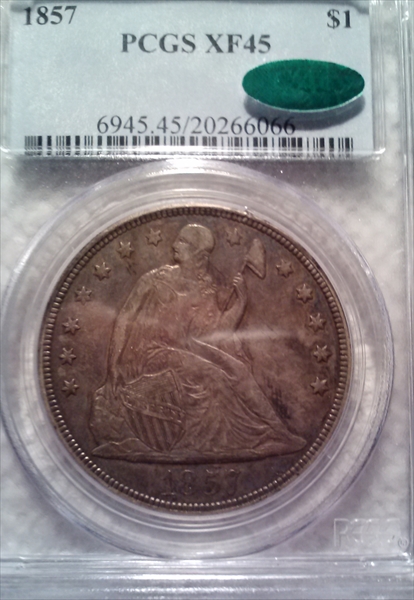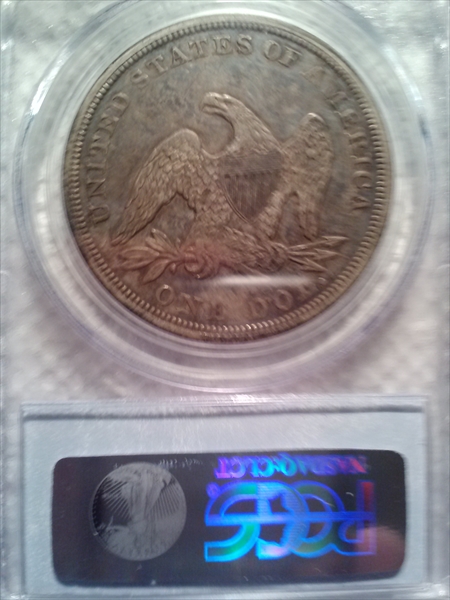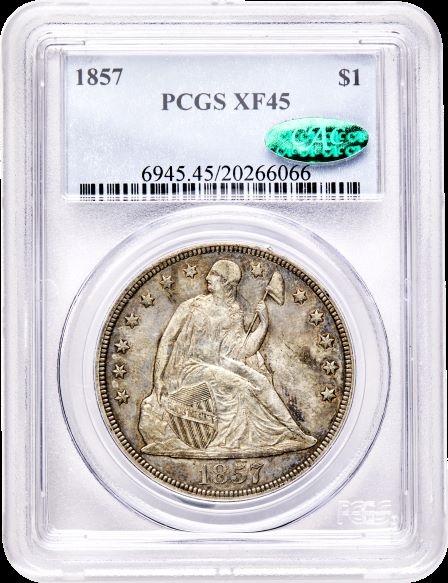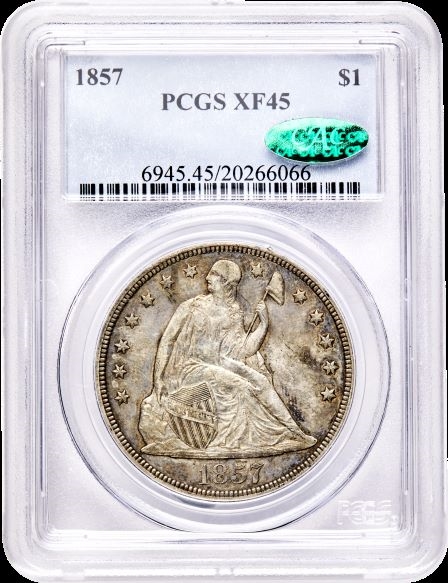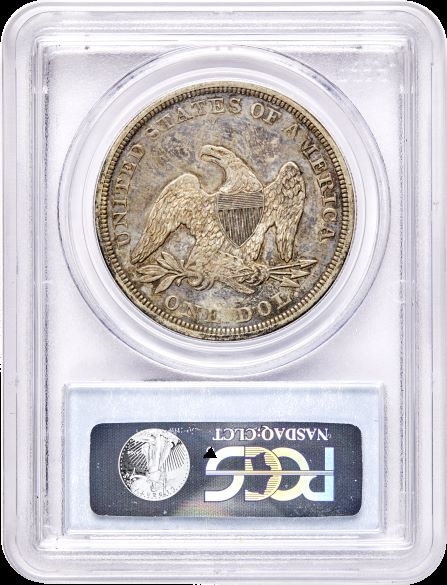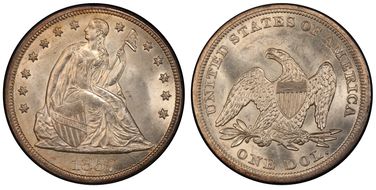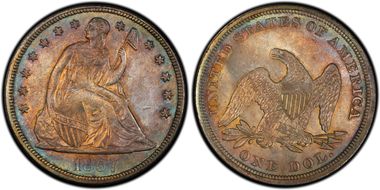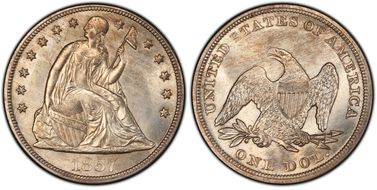1857 $1 XF45 认证号20266066, PCGS号6945
拥有者评论
CAC approved. A crust-errific original coin, well struck for this date with mostly gray toning with traces of russet. A bit of bag chatter in right obverse field hardly detracts.
专家评论
Q. David Bowers
The following narrative, with minor editing, is from my "Silver Dollars & Trade Dollars of the United States: A Complete Encyclopedia" (Wolfeboro, NH: Bowers and Merena Galleries, Inc., 1993).Coinage Context
Again an issue for export: Again, here is a silver dollar issue primarily used in the China trade. Very few if any 1857 silver dollars were used in domestic commerce.
Walter H. Breen notes that the Mint Report includes 94,000 coins June 6th through 30th, but not 490 additional pieces produced by May 29th. Many of the 94,490 coins went to San Francisco by sea, for shipment to China to pay for tea and silk, as in previous years. Others were sent to China from New York and Boston.
A review of legal tender foreign coins: The Act of February 9, 1793 regulated the values of foreign coins and specified which would be legal tender in United States commerce. Excerpt: "Spanish milled dollars, at the rate of one hundred cents for each dollar the actual weight whereof shall not be less than seventeen pennyweights and seven grains; and in proportion for the parts of a dollar." The Act of April 10, 1806 renewed the legal tender status of selected foreign coins. The Act of June 25, 1834 revised the legal tender status of foreign coins and, importantly, did not provide for this status for any coins of less than crown (dollar) size. The Act of March 3, 1843 was somewhat similar in that it, too, provided for selected dollar-size foreign coins to be legal tender, but not fractions of a dollar. Despite the fact that they were not legal tender, the Act of February 21, 1857 provided for the redemption by the Mint of fractional silver coins. By 1857, this redemption could be accomplished safely, for there was now an abundance in circulation of United States silver coins of the lightweight standard as minted since early 1853.
Numismatic Information
Circulated grades: In circulated grades the 1857 is very rare, somewhat approaching the 1854 and 1855 in this regard, but not quite in the same league with them. As 94,490 were minted and as only a few hundred exist today, most must have been melted, probably in China. Others may have been melted at the Philadelphia Mint in 1861 to provide bullion for subsidiary coins.
Apparently, all 1857 circulation strike dollars were made with at least a degree of prooflike surface. Examples in grades such as EF and AU show prooflike surface when seen today.
Mint State grades: In this grade the 1857 dollar is quite rare but still is one of the most available (with 1853) Philadelphia Mint issues of the 1850s up to this point. When seen, Mint State coins almost always have a prooflike surface and are nearly always lightly struck, particularly at the upper part of the obverse. In years past it was common practice for collectors and dealers alike to call such coins "Proofs," a situation which skews the historical data concerning this date.
There are a few better strikes, very few. One was described by James C. Cray (letter to the author, June 19, 1992). "The specimen in my collection is frosty Uncirculated without even a hint of prooflike surface. It is fully struck on the head, the obverse stars, and the eagle's legs and talons. The only area of weakness is a softness at the top of the eagle's left wing."
Another remarkable exception is a specimen David W. Akers owned in 1993, which exhibited sharply struck stars and lustrous frosty surfaces.
Varieties
Circulation strikes:
1-2. Normal Date: Breen-5455. Two pairs of dies were made for circulation strikes. All higher grade examples I have seen are prooflike, sometimes with fully mirrorlike surfaces, but flatly struck (due to non-parallel die alignment) at Miss Liberty's head, the upper stars, and (sometimes but not always) on certain areas of the reverse, particularly the upper parts of the eagle. One example seen (B&M Somerset Collection sale, May 1992, Lot 1145; an MS-63 coin) was lightly struck on Miss Liberty's head and most stars, but was well struck on the reverse; this piece had an area of die roughness between the denticles and the lower left base of Miss Liberty, and a similar area of roughness on the right.
Dies prepared: Obverse: Unknown; Reverse: Unknown
Circulation strike mintage: 94,490; (The May 29th delivery of 490 pieces was omitted in error from both the 1857 Annual Report and calendar year statistics published by the Mint in the 1880s. It is possible that this small number of coins represents a special striking for unknown purposes. Reference: R.W. Julian, "Philadelphia Coinage Statistics: 1853-1873. The Silver Dollar," Numismatic Scrapbook Magazine, August 1964.)
Delivery figures by day: May 29: 490; June 6: 10,000; June 13: 20,000; June 16: 25,000;June 27: 31,000;June 30: 8,000.
Estimated quantity melted: Unknown
Characteristics of striking: Nearly always weakly struck at top of the obverse (Miss Liberty's head and stars 5 through 10). Some coins are almost flat in this area. Other coins are weak on the obverse but quite well struck on the reverse. Most coins were made with prooflike surfaces.
Known hoards of Mint State coins: None
Commentary
Like its immediate predecessors in the series, the 1857 Liberty Seated dollar was used primarily in the China trade. Circulation strike coins were made with prooflike surfaces. This date is much rarer than generally known.
Additional Information
Prices Paid at the Mint
In a letter dated February 6, 1857, to Hon. James Guthrie, secretary of the Treasury, Director of the Mint James Ross Snowden noted that although earlier laws had made Spanish and other dollars legal tender at the Mint, the same was not true of fractional denominations. Notwithstanding this, the minor coins have "held a far larger place in our currency than any or all others [Mexican dollars, etc.] named in those acts." Snowden said that many fractional coins had been received at the Mint for recoining into U.S. silver denominations.
The average buying price for coins at the Mint was as follows: Spanish [i.e., Spanish American, mostly Mexican] pillar dollars $1.053.
But: "There is a class of dollars which is generally mistaken for the true Spanish pillar dollar, but is decidedly inferior, being worth only $1.01 on the average, and withal very irregular. They were coined by the royal party in the revolutionary times of Mexico, and may be known by their defaced appearance, which is not due to wear, but to blows of the hammer, by which they were coined, whence they are called hammered dollars."
Dollars of Mexico, mixed $1.063.
Dollars of Peru, prior to recent changes $1.065. Dollars of Bolivia $1.065.
Dollars of Central America $1.027. Five francs of France, mixed $0.99.
Worn Spanish quarters $0.235. (Spanish halves, or 4-real pieces, circulated but were few in number. Judging from coins surviving today (in the 1990s), the most popular fractional denomination was the 2-real or quarter piece.)
Worn Spanish eighths $0.109.
Worn Spanish sixteenths $.052.
An Early Numismatic Society
In 1857, steps were taken to form a coin collectors' society in Philadelphia. The Proceedings of the Numismatic and Antiquarian Society of Philadelphia, January 4, 1866, gave a capsule history of the organization:
"The preliminary meeting to take into consideration the propriety of forming a Numismatic Society was held on the 28th of December 1857, on which occasion seven gentlemen were present. It was then resolved to form such a Society; a meeting was called for January 1, 1858, and organized regularly. At this meeting eight gentlemen were present; one of those present at the former meeting not being present at this or any subsequent meeting of this Society, although he became a member, and remained one until December 1859, when he resigned.
"During the year 1858 there were elected 16 members, making the total January 1, 1859, 25. During 1859 there were elected 13, and one resigned, making on January 1, 186037. During 1860 there were five elected, and two resigned, making the number 40 on the first of January 1861. During this year there were four elected, one died, one resigned, making 42 on January 1, 1862."
By early 1866 the number of members stood at 55. In addition, the director of the Mint James Pollock, was an ex officio or honorary member of the Society. It is probably accurate to say that the most serious collectors in the Philadelphia area belonged to the Society. This gives an indication of those who may have been doing some "business" with the Mint during the 1860s, buying restrikes, etc. James Ross Snowden, was a member ex officio, and after his Mint directorship ended in April 1861, he requested to retain (or renew?) his honorary membership, which was printed in April 1866 by the Society. This indicates that Snowden maintained an active interest in numismatics and personally interfaced with collectors in the Philadelphia area.
The following founded the Society in 1857-1858: John Bohlen, Arthur G. Coffin, Mark Wilkes Collet, M.D., Samuel H. Fulton, Montgomery L. Frederick, J. Ludger Hodge, Joseph J Mickley, Alfred Bates Taylor, and William S. Vaux. At one time Gulian C. Verplanck, of Hard Times token fame, was an honorary member, as was erstwhile 1848 presidential candidate Lewis Cass, who was well known as an amateur historian.
The Panic of 1857
In 1857 the American economy paused to catch its breath, sneezed, and caught a cold. For the first time since the revival of prosperity, after the Panic of 1837 and its after-effects (which lasted until about 1844), there was a financial crisis. Securities dropped in value during the summer, and on August 24th the Ohio Life & Trust Company failed. On September 12th and 13th, numerous banks in Baltimore, Washington, and Philadelphia suspended operations. On October 13th, all but one New York City bank halted operations. Stocks continued to fall. It was estimated that over 20,000 people lost their jobs in New York City in October. However, in New Orleans the banks showed remarkable strength, and of nine banks reporting from that city, only four suspended operations, and these halted business for just a few days.
The Bankers' Magazine and Statistical Register, October 1857, printed this commentary: "In September there was a financial crisis in New York. This could be ascribed to two things-unfavorable foreign trade and unsound banking. Over $32 million worth of gold had been shipped from New York City for the preceding 37 weeks ending on September 19, 1857, thereby draining the banks of their specie reserve and forcing the draw on other cities. At the same time there were systematic efforts of the part of one or two New York journals to create a panic in the money market, by discredit 'of railroad securities and rumors prejudicial to the credit of the city and country banks.
"Further, various banks in the cities endeavored to obtain deposits from interior areas by offering unreasonably high rates of interest on balance. The average interest paid was 4%, and loans were ordinarily made at 7%, or in some cases at 8 to 12%. At the same time, the needs of railroad companies forced them to obtain some loans in the New York financial district to high rates of interest. The suspension of the Ohio Life & Trust Company, who had borrowed $2 million from the banks, caused a credit crunch.
"The pressure prevailing in the money market up to the 17th was heightened at that time and for some days afterwards by the intelligence of the loss of the California steamer Central America, holding on board about $2 million of gold, according to present estimates. The very prompting commemorable action of the Board of Underwriters, on hearing of the accident, will do much to mitigate the inconvenience of the loss, a payout [upon] advice of the amount, at once. All drafts drawn against the gold will, therefore, be honored on presentation at the respective banks and banking houses in which they are drawn ....
"On the 25th of September the Bank of Pennsylvania and the Girard Bank of Philadelphia suspended specie payments. The next day, Saturday, a general suspension of specie was conducted by other banks in Philadelphia and in Baltimore. Soon, many banks in Virginia, Pennsylvania, and other states also suspended specie."
In October 1857 many banks in other major cities, including New York, suspended specie payments. On December 11, bankers voted unanimously to resume specie payments. In a retrospective printed in the May 1858 issue, The Bankers' Magazine and Statistical Register stated that land speculation contributed to the panic of 1857.
PCGS #
6945
设计师
Christian Gobrecht
边缘
Reeded
直径
38.10 毫米
重量
26.73 克
铸币数量
94490
金属成分
90% Silver, 10% Copper
更高评级数量
116
评级较低的钱币数量
28
地区
The United States of America
价格指南
PCGS 数量报告
拍卖 - PCGS 评级的
拍卖 - NGC 评级的
稀有性和存量估计 了解更多
| 所有评级 | 1100 |
| 60或以上 | 100 |
| 65或以上 | 2 |
| 所有评级 | R-4.9 |
| 60或以上 | R-8.0 |
| 65或以上 | R-9.9 |
| 所有评级 | 5 / 30 TIE |
| 60或以上 | 19 / 30 TIE |
| 65或以上 | 7 / 30 TIE |
| 所有评级 | 12 / 45 TIE |
| 60或以上 | 28 / 45 TIE |
| 65或以上 | 8 / 45 TIE |




















